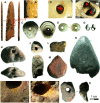Bows and arrows and complex symbolic displays 48,000 years ago in the South Asian tropics
- PMID: 32582854
- PMCID: PMC7292635
- DOI: 10.1126/sciadv.aba3831
Bows and arrows and complex symbolic displays 48,000 years ago in the South Asian tropics
Abstract
Archaeologists contend that it was our aptitude for symbolic, technological, and social behaviors that was central to Homo sapiens rapidly expanding across the majority of Earth's continents during the Late Pleistocene. This expansion included movement into extreme environments and appears to have resulted in the displacement of numerous archaic human populations across the Old World. Tropical rainforests are thought to have been particularly challenging and, until recently, impenetrable by early H. sapiens. Here, we describe evidence for bow-and-arrow hunting toolkits alongside a complex symbolic repertoire from 48,000 years before present at the Sri Lankan site of Fa-Hien Lena-the earliest bow-and-arrow technology outside of Africa. As one of the oldest H. sapiens rainforest sites outside of Africa, this exceptional assemblage provides the first detailed insights into how our species met the extreme adaptive challenges that were encountered in Asia during global expansion.
Copyright © 2020 The Authors, some rights reserved; exclusive licensee American Association for the Advancement of Science. No claim to original U.S. Government Works. Distributed under a Creative Commons Attribution NonCommercial License 4.0 (CC BY-NC).
Figures




Similar articles
-
Homo sapiens lithic technology and microlithization in the South Asian rainforest at Kitulgala Beli-lena (c. 45 - 8,000 years ago).PLoS One. 2022 Oct 13;17(10):e0273450. doi: 10.1371/journal.pone.0273450. eCollection 2022. PLoS One. 2022. PMID: 36227910 Free PMC article.
-
Microliths in the South Asian rainforest ~45-4 ka: New insights from Fa-Hien Lena Cave, Sri Lanka.PLoS One. 2019 Oct 2;14(10):e0222606. doi: 10.1371/journal.pone.0222606. eCollection 2019. PLoS One. 2019. PMID: 31577796 Free PMC article.
-
Fruits of the forest: Human stable isotope ecology and rainforest adaptations in Late Pleistocene and Holocene (∼36 to 3 ka) Sri Lanka.J Hum Evol. 2017 May;106:102-118. doi: 10.1016/j.jhevol.2017.01.015. Epub 2017 Mar 21. J Hum Evol. 2017. PMID: 28434535
-
India at the cross-roads of human evolution.J Biosci. 2009 Nov;34(5):729. doi: 10.1007/s12038-009-0056-9. J Biosci. 2009. PMID: 20009268 Review.
-
The origin and evolution of Homo sapiens.Philos Trans R Soc Lond B Biol Sci. 2016 Jul 5;371(1698):20150237. doi: 10.1098/rstb.2015.0237. Philos Trans R Soc Lond B Biol Sci. 2016. PMID: 27298468 Free PMC article. Review.
Cited by
-
Homo sapiens lithic technology and microlithization in the South Asian rainforest at Kitulgala Beli-lena (c. 45 - 8,000 years ago).PLoS One. 2022 Oct 13;17(10):e0273450. doi: 10.1371/journal.pone.0273450. eCollection 2022. PLoS One. 2022. PMID: 36227910 Free PMC article.
-
Riddles wrapped inside an enigma. Lupemban MSA technology as a rainforest adaptation: revisiting the lanceolate point.Philos Trans R Soc Lond B Biol Sci. 2022 Apr 25;377(1849):20200484. doi: 10.1098/rstb.2020.0484. Epub 2022 Mar 7. Philos Trans R Soc Lond B Biol Sci. 2022. PMID: 35249391 Free PMC article.
-
A worked bone assemblage from 120,000-90,000 year old deposits at Contrebandiers Cave, Atlantic Coast, Morocco.iScience. 2021 Sep 16;24(9):102988. doi: 10.1016/j.isci.2021.102988. eCollection 2021 Sep 24. iScience. 2021. PMID: 34622180 Free PMC article.
-
Tropical forests in the deep human past.Philos Trans R Soc Lond B Biol Sci. 2022 Apr 25;377(1849):20200500. doi: 10.1098/rstb.2020.0500. Epub 2022 Mar 7. Philos Trans R Soc Lond B Biol Sci. 2022. PMID: 35249383 Free PMC article.
-
Systematic bone tool production at 1.5 million years ago.Nature. 2025 Apr;640(8057):130-134. doi: 10.1038/s41586-025-08652-5. Epub 2025 Mar 5. Nature. 2025. PMID: 40044851 Free PMC article.
References
-
- James H. V. A., Petraglia M. D., Modern human origins and the evolution of behavior in the later Pleistocene record of South Asia. Curr. Anthropol. 46, S3–S27 (2005).
-
- Roberts P., Perera N., Wedage O., Deraniyagala S., Perera J., Eregama S., Gledhill A., Petraglia M. D., Lee-Thorp J. A., Direct evidence for human rainforest resource reliance in Late Pleistocene Sri Lanka. Science 347, 1246–1249 (2015). - PubMed
-
- Roberts P., Perera N., Wedage O., Deraniyagala S., Perera J., Eregama S., Petraglia M. D., Lee-Thorp J. A., Fruits of the forest: Human stable isotope ecology and rainforest adaptations in Late Pleistocene and Holocene (~ 36 to 3 ka) Sri Lanka. J. Hum. Evol. 106, 102–118 (2017). - PubMed
-
- S. U. Deraniyagala, The Prehistory of Sri Lanka: An Ecological Perspective (Department of Archaeological Survey, 1992).
Publication types
LinkOut - more resources
Full Text Sources
Research Materials
Miscellaneous

